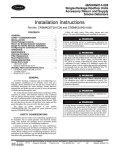Download Service Manual, 9.17, 9.17si Treadmill.fm
Transcript
9.17, 917si Treadmill 9.17, 9.17si Treadmill Warning: This service manual is for use by Precor trained service providers only. If you are not a Precor Trained Servicer, you must not attempt to service any Precor Product; Call your dealer for service. This document contains information required to perform the majority of troubleshooting, and replacement procedures required to repair and maintain this product. This document contains general product information, software diagnostic procedures (when available), preventative maintenance procedures, inspection and adjustment procedures, troubleshooting procedures, replacement procedures and electrical block and wiring diagrams. To move directly to a procedure, click the appropriate procedure in the bookmark section to the left of this page. You may “drag” the separator bar between this page and the bookmark section to change the size of the page being viewed. © 2003 Precor Incorporated Unauthorized Reproduction and Distribution Prohibited By Law. Page 1 917, 917si Treadmillr Section One - Things You Should Know About This Appendix Section One, Things You Should Know. This section includes technical specifications and a procedure matrix. Read this section, as well as the 917, 917si Treadmill Owner’s Manual, before you perform the maintenance procedures in this manual. Section Two, Software Features. Precor’s 917si Treadmill is programmed with several diagnostic and setup features. This section contains the procedures you need to access the diagnostic features on this treadmill. Section Three, Checking Treadmill Operation. This section provides you with a quick way of checking treadmill operation. Check treadmill operation at the end of a maintenance procedure and when it is necessary to ensure that the treadmill is operating properly. Section Four, Inspection and Adjustment Procedures. Perform inspection procedures when a trouble symptom points to a particular problem and after removing and replacing major components. Many maintenance problems can be fixed by adjusting various treadmill components. This section also provides you with the step-by-step procedures required to make these adjustments. Section Five, Troubleshooting Procedures. The diagnostic and troubleshooting procedures contained in this section should be performed when it is necessary to isolate a problem to a particular component. Section Six, Replacement Procedures. When a treadmill component must be replaced, go to this section and follow the step-by-step procedures required to remove and replace the component. Section Seven, Wiring and Block Diagrams. This section includes wiring and block diagrams for 917 and 917si Treadmill. General Information For the latest exploded view, part number and part pricing information, visit the Precor dealer website at “www.precor.com/Dealer”. Page 2 9.17, 917si Treadmill Technical Specifications PHYSICAL SPECIFICATIONS Length: Width: Height: Running surface: Motor: Speed: Incline: Power: Weight: Shipping weight: 60 inches (152 cm) 28 inches (71 cm) 48 inches (122 cm) 18 X 54 inches (46 X 137 cm) 2.0 hp continuous duty 1.0 to 10 mph (1.6 to 16 kph) 10 mph is equivalent to a 6 minute mile 0 to 10% grade 120 Vac, 50/60 Hz 240 Vac, 50/60 Hz 150 lbs (68 kg) 160bs (75.6 kg) ELECTRONIC SPECIFICATIONS 917 Programs: Manual 917Si Programs: Manual Interval Weight Loss 6 Pre-programmed courses (3 Walk, 3 Run) 2 Custom courses Random Heart Rate Course Options Polar Heart Rate System Handrails Page 3 917, 917si Treadmillr Procedure 2.1 - Accessing the Diagnostic Program (917si only) The keys on the display are hypothetically numbered for 1 to 7 from left to right. Therefore, INCLINE ▲ would be key 1, INCLINE ▼ would be key 2, etc. Placing the unit in the diagnostic mode causes the software to perform the following operations: a. Test the LED’s mounted on the upper PCA; b. Provide the option of calibrating the lift system; c. Display the drive motor power bits; d. Test the keyboard; e. Display and test the heart rate function; 1. Plug the power cord into the wall outlet, then turn on the treadmill with the circuit breaker. 2. Press keys RESET,5,1,7,6,5,7,6,1, sequentially. 3. All of the LED’s on the display will light up. Any LED segment that is not lit is defective. Press the SELECT key to continue. 4. After the LED test, the electronic console displays the potentiometer increment number. 5. Verify that the running bed inclines and declines as the INCLINE ▲ or INCLINE ▼ keys are pressed. 6. When the potentiometer increment number is displayed on the electronic console, the potentiometer increment number will track the incline as it is operated. Press the SELECT key to continue. 7. The power bit number will be displayed. Note: When the running belt is started, the number of power bits will be displayed. Power bits represent the amount of power applied to the drive motor. Power bits are the product of selected speed and applied load. 8. Press the SPEED ▲ or SPEED ▼ key. Verify that the power bits number increments and decrements as the SPEED keys are pressed. The Select key will toggle the display between the power bit reading and a mile (or kilometer) per hour reading. 9. Press the STOP key to exit the power bits mode. Page 4 9.17, 917si Treadmill 10. A series of dots will appear on the display. Press each of the keys on the keyboard, the appropriate dot will expand to indicate that the key is functioning. Press and hold the STOP key to continue. 11. If the heart rate option has been installed, you may test the heart rate function using a chest strap transmitter or test transmitter. Press the “SELECT to select U, F, or P heart rate mode. U is unfiltered mode, F is filtered mode and P is Polar mode. The unfiltered mode will display an unmodified heart rate directly from the heart rate transmitter, the filtered mode will display the heart rate averaged over a short period of time and the Polar mode will utilize a Polar filtering system. 12. Press the STOP key to exit the diagnostics program. Diagram 2.1 - 917si Display Key 1 Key 2 Key 3 RESET Key 5 Key 6 Key 7 Page 5 917, 917si Treadmillr Procedure 2.2 - Displaying the Odometer (917si only) The keys on the display are hypothetically numbered for 1 to 7 from left to right. Therefore, INCLINE ▲ would be key 1, INCLINE ▼ would be key 2, etc. This procedure allows you to display the number of miles or kilometers logged on the treadmill. Procedure 1. Plug the power cord into the wall outlet, then turn on the treadmill with the circuit breaker 2. Press keys RESET,6,5, sequentially. 3. The console displays the number of miles or kilometers logged on the treadmill. Press the STOP key to continue. 4. The total number of hours the treadmill drive motor has been operating will be displayed. Press the STOP key to continue. 5. The software version will be displayed. Press the STOP key to continue. 6. The error code log will be displayed. There may be up to ten error codes logged. The error code and the odometer reading when the error occurred will be displayed. Use either ▲ to move forward through the error code log position. Use either ▼ to backward through the error code log. 7. If you no longer require the contents of the error code log for troubleshooting and wish to clear the error code log, press the STOP and QUICK START keys, simultaneously. 8. Press the STOP to exit. Page 6 9.17, 917si Treadmill Procedure 2.3 - Selecting United States Standard or Metric Units (917si only) The keys on the display are hypothetically numbered for 1 to 7 from left to right. Therefore, INCLINE ▲ would be key 1, INCLINE ▼ would be key 2, etc. Selecting United States standard units causes information to be displayed in feet, miles and pounds. Information is displayed in meters, kilometers and kilograms if metric units are selected. After you have selected a measurement standard, the software compiles and records workout information in the units of the measurement standard selected. Changing to the alternate measurement standard after your workout has started will cause invalid data to be displayed. For this reason, change the measurement standard only after turning ON the treadmill. Procedure 1. Plug the power cord into the wall outlet, then turn on the treadmill with the circuit breaker. 2. With the Enter Your Weight banner scrolling, press keys RESET,5,6,7, sequentially. 3. The current setting, either U.S. Standard or Metric will be displayed. 4. Use the ▲ or ▼ keys to select the desired unit of measurement setting. 5. Press the STOP key to exit, Page 7 917, 917si Treadmillr Procedure 2.4 - Documenting Software Problems When a problem is found with either the PROM or upper or lower PCA’s, record the information listed below. If you isolated the problem to either the PROM, upper PCA, or lower PCA, include the information with the malfunctioning PROM or PCA when you ship it to Precor Customer Service. When a problem occurs, record the following information: • Model and serial number. • Software version number. • User and program number running when the problem occurred. • A description of: • a. What happened or failed to happen. b. The action taken by the user just before the problem occurred. c. Problem-related information (such as how far into the program the problem occurred, the work level being used when the problem occurred, etc.) The frequency of occurrence. Page 8 9.17, 917si Treadmill Section Three - Checking Treadmill Operation This section provides you with a quick method of checking treadmill operation. Check treadmill operation at the end of a maintenance procedure and when it is necessary to ensure that the treadmill is operating properly. Procedure 1. Plug the power cord into the wall outlet, then turn on the treadmill with the circuit breaker. 2. Adjust the speed of the running belt to 2–3 mph. 3. Operate the treadmill for at least 5 minutes. a. Check the running belt alignment. If necessary, adjust the running belt tracking per Procedure 4.3. b. Concentrate on the feel of the running belt and the sound of the drive motor and rollers. Be alert for running belt or drive belt slippage, unusual noises, smells, or vibrations. c. Measure and log the AC input current under loaded and unloaded conditions. 4. Press the INCLINE ▲ key while viewing the electronic console. Confirm that the running bed inclines and the incline display increments to 10 percent as the INCLINE ▲ key is pressed. 5. Press the INCLINE ▼ key while viewing the electronic console. Confirm that the running bed returns to a level position and the incline display decrements to zero percent as the INCLINE ▼ key is pressed. 6. Check for targa looseness. The targa should not move back and forth with your body weight. The targa should not creak or rattle as the treadmill is used. 7. Inspect the running deck trim strips for looseness. The running deck trim strips must be securely snapped into place. Turn off the treadmill with the circuit breaker, then unplug the treadmill from the wall outlet. Page 9 917, 917si Treadmillr Procedure 4.1 - Calibrating the Lift (917 only) WARNING Always turn off the circuit breaker and unplug the treadmill before you remove the treadmill hood. Procedure 1. Remove the top front and bottom front covers. 2. Lay the treadmill on it’s side and the unsnap lift platform wheel axle from the lift platform. Remove the wheels and axle from the lift motor tube. See Diagram 4.1. Diagram 4.1 - Lift Platform Lift Platform Wheel (4) Lift Platform Axle Lift Motor Tube 3. Plug the AC line cord into an AC outlet and set the circuit breaker in the “on” position. 4. Connect a digital multimeter, set for DC volts, between terminals 5 (blue) and 6 (brown) of the P7 lift motor connector on the lower PCA. Operate the lift until the voltmeter reading is as close to 0.35 Vdc as possible. Set the circuit breaker in the “off” position. Allow about 5 seconds for the power supply voltage to bleed off, the green LED on the lower PCA will go out. Page 10 9.17, 917si Treadmill 5. Remove the P7 lift motor connector from the lower PCA. Thread the lift tube counterclockwise far enough so that you can comfortably grasp the lift motor drive screw. Set the digital multimeter for ohms and leave it connected as in step 4. Turn the lift motor drive screw, by hand, until the meter reads 98 ± 2Ω. 6. Thread the lift tube onto the lift drive screw until the distance between the top of the lift tube and the lift motor is 6-3/4 inches ± 1/8 inch. See Diagram 4.2 Be sure that the lift motor drive screw does not turn as you turn the lift tube. If the drive screw turns the resistance reading in step 5 will change. The ohmmeter must reads 98Ω after the lift tube has been threaded into position. Re-insert the P7 lift motor connector in the lower PCA. Diagram 4.2 - Lift Motor 6-3/4” 7. Slide the lift platform axle into the lift motor tube. Rotate the lift tube only enough to line up with the lift platform. Slide two wheels onto each end of the lift platform axle. Align the wheels with the wheel slots in the lift platform and snap the lift platform axle into the lift platform. 8. Set the treadmill upright. Set the circuit breaker in the “on” position. Operate the lift between 0% and 10% several time to ensure that the lift is functioning normally. Page 11 917, 917si Treadmillr Procedure 4.2 - Calibrating the Lift (917si only) WARNING Always turn off the circuit breaker and unplug the treadmill before you remove the treadmill hood. Procedure 1. Lay the treadmill on it’s side and unsnap the lift platform wheel axle from the lift platform. Remove the wheels and axle from the lift motor tube. See Diagram 4.1. 2. Set the circuit breaker in “on” position. Access the diagnostics program, as in Procedure 2.1, and proceed to the lift potentiometer increment number. Operate the lift until the lift potentiometer increment number is 20. 3. Thread the lift tube onto the lift drive screw until the distance between the top of the lift tube and the lift motor is 6-3/4 inches ± 1/8 inch. See Diagram 4.2 Be sure that the lift motor drive screw does not turn as you turn the lift tube. If the drive screw turns the potentiometer increment number in step 3 will change. The potentiometer increment number must be 20 after the lift tube has been threaded into position. 4. Exit the diagnostic program and set the circuit breaker in the “off” position. 5. Slide the lift platform axle into the lift motor tube. Rotate the lift tube only enough to line up with the lift platform. Slide two wheels onto each end of the lift platform axle. Align the wheels with the wheel slots in the lift platform and snap the lift platform axle into the lift platform. 6. Set the treadmill upright. Set the circuit breaker in the “on” position. Operate the lift between 0% and 10% several time to ensure that the lift is functioning normally. Page 12 9.17, 917si Treadmill Procedure 4.3 - Running Belt Tensioning and Tracking WARNING Always turn off the circuit breaker and unplug the treadmill before you remove the treadmill hood. 1. The basic running belt tensioning and tracking procedure described in the Residential Treadmill service manual (part # 20081-101) may be used to tension and track the 917 or 917si treadmill with a few exceptions. 2. The drive roller on the 917 and 917si is a “fixed” mount. The drive roller is not moveable or adjustable and does not play a part in the running belt tracking procedure. 3. The 917 and 917si treadmills use belt guides. The belt guides make the tracking procedure easier in that the adjustment does not need to be as exacting without the belt guides. 4. The 917 and 917si running belt tension is 0.3%. Page 13 917, 917si Treadmillr Procedure 4.4 - Drive Belt Tensioning 1. If the running bed is mounted in the treadmill, it may need to be moved slightly to gain access to the upper surface of the drive belt. The drive belt tension test must be performed in the center of the belt span between the drive roller pulley and the drive motor pulley. 2. If the running bed is mounted, running bed belt guides on the bottom of the running bed and the screws that mount the running bed to the frame. Lift and slide the running bed just far enough out of the right side of the running belt to expose the drive belt. 3. Place a belt gauge (Precor part # 20030-117 or equivalent) in the middle of the drive belt and in the center of the belt span (see Diagram 5.3). Lay a straight edge along the length of the belt and beside the belt gauge. Slide one of the o-rings up against the shoulder of the belt gauge. Press downward on the belt gauge, causing the belt to deflect. Read the deflection on the belt gauge at the edge of the straight edge. Deflect the belt 1/2”. Read the tension across the top edge of the o-ring. If the belt is correctly tensioned the gauge will read between 14 and 16 pounds. See Diagram 4.3. Diagram 4.3 - Drive belt Tension Gauge 15 lbs 1/2” Page 14 9.17, 917si Treadmill IF... The belt tensioning gauge reads less than 14 pounds THEN... Turn the drive belt tension bolt clockwise, until the belt tensioning gauge reads 14-16 pounds @1/2” deflection. The belt tensioning gauge reads more than 16 pounds Turn the drive belt tension bolt counterclockwise, until the belt tensioning gauge reads 14-16 pounds @ 1/2” deflection. 4. When the belt tension is correctly set tighten the jam nut to lock the tension setting. 5. If necessary, slide the running bed back into place. Replace and tighten the running bed mounting bolts. Replace both running belt guides. Diagram 4.4 - Drive Belt Tensioner Tension Adjustment Bolt Drive Belt Tensioner Jam Nut Page 15 917, 917si Treadmillr Procedure 5.1 - Troubleshooting Keypad Function (917 only) If the function keys on the electronic console are unresponsive, the problem may be either the upper PCA or keypad. This troubleshooting procedure gives you the information you need to determine which of these components is malfunctioning. Procedure 1. Set the circuit breaker in the “off” position. WARNING Before continuing with this procedure, review the Warning and Caution statements listed in Section One of the Residential Treadmill Service Manual. 2. Remove the screws that secure the upper display assembly to the upper handrail. Carefully, pull some excess interconnect cable out from the targa upright. Rotate the display housing, so that the rear of the upper PCA is facing upward, and set the display housing on the upper handrail. 3. Attach the wrist strap to your arm, then connect the ground lead of the wrist strap to the treadmill frame. Diagram 5.1 - 917 Upper PCA, Rear View Pin # 1 Keypad Connector Keypad Cable Interconnect Cable 4. Set the voltmeter to a range that will conveniently read +6 Vdc. 5. Set the circuit breaker in the “on” position. Page 16 9.17, 917si Treadmill 6. Use a DVM, set for DC volts, and read between pin 6 of J2 and the each of the pins in Table 5.1 (no keys pressed) and Table 5.2 (with the appropriate key pressed)... Table 5.1. Voltage Test Points (Function Keys Not Pressed) Place the positive lead of the voltmeter on... Pin 3 of J2 Pin 4 of J2 Pin 5 of J2 Pin 7 of J2 Pin 8 of J2 Pin 9 of J2 The voltmeter should read... 5 Vdc ± 500 mVdc 5 Vdc ± 500 mVdc 5 Vdc ± 500 mVdc 5 Vdc ± 500 mVdc 5 Vdc ± 500 mVdc 5 Vdc ± 500 mVdc Table 5.2. Voltage Test Points (Function Keys Pressed) Place the positive voltmeter lead on... Pin 3 of J2 Pin 4 of J2 Pin 5 of J2 Pin 7 of J2 Pin 8 of J 2 Pin 9 of J2 At the electronic console, press... SELECT/ENTER INCLINE ▼ INCLINE ▲ STOP SPEED ▼ SPEED ▲ The voltmeter should read between... 0 Vdc and 500 mVdc 0 Vdc and 500 mVdc 0 Vdc and 500 mVdc 0 Vdc and 500 mVdc 0 Vdc and 500 mVdc 0 Vdc and 500 mVdc 7. If the voltage readings match those listed in Tables 5.1 and 5.2 and one or more keys do not function, replace the upper PCA. 8. If the voltage readings in Table 5.1 are incorrect, disconnect the keypad cable from the key pad connector and repeat the voltage measurements in 5.1. If the voltage readings are now correct, replace the display housing (keypad). If the voltage readings are still incorrect, replace the upper PCA. 9. If the voltage readings in Table 5.1 are correct and one or more voltage readings in Table 5.2 are incorrect, replace the display housing (keypad). 10. Set the circuit breaker in the “off” position. 11. If necessary, carefully re-connect the keypad cable to the keypad connector. 12. Remove the ground lead of the wrist strap from the treadmill frame, then remove the wrist strap from your arm. 13. Position the display enclosure on the display plate. Install the screws that secure the display enclosure to the display plate. 14. Check the operation of the treadmill as described in Section Three of this appendix. Page 17 917, 917si Treadmillr Procedure 5.2 - Troubleshooting Keypad Function (917si only) If the function keys on the electronic console are unresponsive, the problem may be either the upper PCA or keypad. This troubleshooting procedure gives you the information you need to determine which of these components is malfunctioning. Procedure 1. Set the circuit breaker in the “off” position. WARNING Before continuing with this procedure, review the Warning and Caution statements listed in Section One of the Residential Treadmill Service Manual. 2. Remove the screws that secure the upper display assembly to the upper handrail. Carefully, pull some excess interconnect cable out from the targa upright. Rotate the display housing, so that the rear of the upper PCA is facing upward, and set the display housing on the upper handrail. 3. Attach the wrist strap to your arm, then connect the ground lead of the wrist strap to the treadmill frame. Diagram 5.2 - 917si Upper PCA, Rear View Pin # 1 Keypad Connector Keypad Cable Interconnect Cable 4. Set the voltmeter to a range that will conveniently read +6 Vdc. Page 18 9.17, 917si Treadmill 5. Set the circuit breaker in the “on” position. 6. Use a DVM, set for DC volts, and read between pin 6 of J3 and the each of the pins in Table 5.1 (no keys pressed) and Table 5.2 (with the appropriate key pressed)... Table 5.1. Voltage Test Points (Function Keys Not Pressed) Place the positive lead of the voltmeter on... Pin 3 of J3 Pin 4 of J3 Pin 5 of J3 Pin 7 of J3 Pin 8 of J3 Pin 9 of J3 Pin 10 of J3 The voltmeter should read... 5 Vdc ± 500 mVdc 5 Vdc ± 500 mVdc 5 Vdc ± 500 mVdc 5 Vdc ± 500 mVdc 5 Vdc ± 500 mVdc 5 Vdc ± 500 mVdc 5 Vdc ± 500 mVdc Table 5.2. Voltage Test Points (Function Keys Pressed) Place the positive voltmeter lead on... Pin 3 of J3 Pin 4 of J3 Pin 5 of J3 Pin 7 of J3 Pin 8 of J3 Pin 9 of J3 Pin 10 of J3 At the electronic console, press... SELECT/ENTER INCLINE ▼ INCLINE ▲ STOP SPEED ▼ SPEED ▲ QUICK START The voltmeter should read between... 0 Vdc and 500 mVdc 0 Vdc and 500 mVdc 0 Vdc and 500 mVdc 0 Vdc and 500 mVdc 0 Vdc and 500 mVdc 0 Vdc and 500 mVdc 0 Vdc and 500 mVdc 7. If the voltage readings match those listed in Tables 5.1 and 5.2 and one or more keys do not function, replace the upper PCA. 8. If the voltage readings in Table 5.1 are incorrect, disconnect the keypad cable from the key pad connector and repeat the voltage measurements in 5.1. If the voltage readings are now correct, replace the display housing (keypad). If the voltage readings are still incorrect, replace the upper PCA. 9. If the voltage readings in Table 5.1 are correct and one or more voltage readings in Table 5.2 are incorrect, replace the display housing (keypad). 10. Set the circuit breaker in the “off” position. 11. If necessary, carefully re-connect the keypad cable to the keypad connector. 12. Remove the ground lead of the wrist strap from the treadmill frame, then remove the wrist strap from your arm. 13. Position the display enclosure on the display plate. Install the screws that secure the display enclosure to the display plate. 14. Check the operation of the treadmill as described in Section Three of this appendix. Page 19 917, 917si Treadmillr Procedure 5.3 - Troubleshooting the Lift System System Description The lift system is powered by a 120 Vac lift motor that uses two independent motors windings, one operates the motor in an upward direction and one operates the motor in a downward direction. The motor contains a 1 KΩ potentiometer, driven by the motor, that indicates lift position. AC power to operate the lift motor is provided by a pair of triacs. One triac provides power to the “up” winding of the lift motor and the other triac provides power to the “down” winding of the lift motor. The triacs are controlled either manually or by software control from the upper PCA. 1. If the lift motor will not move skip to step 8. If the lift motor moves and an error occurs continue with step 2. 2. For 917si treadmills, skip to step 3. For 917 treadmills, calibrate the lift per Procedure 4.1. If the lift error still occurs, continue with step 4. 3. Access the diagnostics program per Procedure 2.1 and proceed to the lift calibration portion of the diagnostics program. If the lift calibration number is 0 or 255 skip to step 4. Operate the lift, if the lift calibration number does not increment as the lift moves, skip to step 4. If the calibration number increments as the lift moves, re-calibrate the lift per Procedure 4.2. If recalibration does not correct the problem, continue with step 4. 4. Set the treadmill circuit breaker in the “off” position. Using an ohmmeter, measure between terminal 4 (brown wire) and terminal 6 (orange wire) of the P7 connector on the lower PCA. The measurement should be approximately 1 KΩ. If the measurement is open (∞) or significantly high or low, replace the lift motor. 5. Using an ohmmeter, measure between terminals 4 and 5 of P7 and measure between 5 and 6 of P7 on the lower PCA. The two measurements should total approximately 1 KΩ. If the measurement is open (∞) or significantly high or low, replace the lift motor. 6. If you have performed all of the above tests and an error still occurs when the lift motor operates, there are three parts that could cause the problem. There are not any good tests to check these parts other than substituting a known good part. They are lower PCA, ribbon cable and upper PCA. Replace only one part at a time. If the new part does not correct the problem replace the original part. 7. If you have performed all of the above tests and the lift system is still not functioning, call Precor Technical Support. 8. Set the treadmill circuit breaker in the “off” position. Remove the F2 (2 amp slow blow) fuse from the lower PCA. Measure the fuse with an ohmmeter. The measurement should be 1Ω or less. If the fuse is good, re-insert the fuse and skip to step 10. If the fuse is open (∞)or significantly high, replace the fuse. Before operating the lift motor it is necessary to perform a continuity test on the lift motor. Page 20 9.17, 917si Treadmill 9. Remove the P7 connector from the lower board. Using an ohmmeter, measure between terminals 1 and 3 of P7, between terminals 1 and 2 of P7 and between terminals 2 and 3 of P7. The measurements should be approximately 49.5Ω, 47.5Ω and 97Ω, respectively. If any of the measurements are significantly low or high, replace the lift motor. 10. Re-insert the P7 connector in the lower PCA. Set the treadmill circuit breaker in the “on” position. Using an AC voltmeter, monitor the voltage between terminals 1 and 2 (red and white wires) of the P7 connector. Enter the manual program and press the INCLINE ▲ key. The measurement should be approximately 120 Vac (line voltage). If the voltage is present and the lift motor moves normally, skip to step 10. The voltage will only be present until such time as an error occurs. If line voltage is not present skip to step 11. If line voltage is measured but the motor does not move, replace the lift motor. 11. Monitor terminals 1 and 3 (white and black wires) of P7. Enter the manual program and press the INCLINE ▼ key. The measurement should be approximately 120 Vac (line voltage). If the voltage is present and the lift motor moves normally skip to step 12. The voltage will only be present until such time as an error occurs. If line voltage is measured but the motor does not move, replace the lift motor. 12. If line voltage is not present in both steps 9 and 10, there are three parts that could cause the problem. There are not any good tests to check these parts other than substituting a known good part. They are lower PCA, ribbon cable and upper PCA. Replace only one part at a time. If the new part does not correct the problem replace the original part. 13. If you have performed all of the above tests and the lift system is still not functioning, call Precor Technical Support. Page 21 917, 917si Treadmillr Procedure 5.4 - Troubleshooting the Speed Sensor 1. Remove the top front and bottom front covers. 2. Plug the line cord into an AC outlet and set the circuit breaker in the “on” position. 3. Use a digital voltmeter, set for DC volts, to measure the voltage between terminal 1 (green) and terminal 2 (white) of the J1 connector on the lower PCA. 4. Slowly rotate the drive motor, the voltage should alternately switch from near 0 Vdc to near 5 Vdc as the target disk passes through the speed sensor. Diagram 5.3 - Speed Sensor Drive Motor Drive Belt Target Disk Tensioner Speed Sensor Motor Mounting Bolts 5. If the voltage in step 4 switches between approximately 0 Vdc and 5 Vdc, the speed sensor is functioning correctly. 6. If the voltage in step 4 is incorrect, remove the J1 connector from the lower PCA. Measure the voltage between terminals 1 an 4 of the J1 connector on the lower PCA. Terminals 1 and 4 are the terminals that mate with the green and red wires when the speed sensor connector is inserted into the lower board. If the voltage does not measure approximately 5 Vdc, replace the lower PCA. Page 22 9.17, 917si Treadmill 7. If the voltage in step 4 is incorrect and the voltage in step 6 is correct, either the speed sensor or the lower PCA could be defective. Substitute a known good speed sensor and see if that corrects the problem. If not, substitute a known good lower PCA. 8. If you have performed all of the above tests and the speed sensor is still not functioning, call Precor Technical Support. Page 23 917, 917si Treadmillr Procedure 5.5 - Troubleshooting the External A.C. Power Source It is extremely important that any Precor treadmill be connected to and operated on a dedicated 20 amp A.C. circuit. A 20 amp dedicated circuit is defined as: a circuit fed by a 20 amp circuit breaker that feeds a single load. A treadmill operating from a non-dedicated circuit or a circuit breaker of less than 20 amps capacity will not have the necessary power available to operate normally under higher load conditions. The lack of available power can cause any number of symptoms ranging from numerous intermittent (seemingly inexplicable) error conditions, poor speed control, or tripping the house circuit breaker. If any of the above symptoms exist the external A.C. circuit must be checked and confirmed to be a 20 amp dedicated circuit before troubleshooting the treadmill. In addition the A.C. voltage must be checked. Nominal A.C. operating voltage on 120 Vac circuits is 105 Vac to 120 Vac. Nominal A.C. operating voltage on 240 Vac circuits is 208 Vac to 240 Vac. For operator safety considerations and to minimize electrostatic discharge conditions the A.C. frame ground continuity must also be verified to be a low resistance connection to the A.C. distribution ground bar. Important If the A.C. circuit feeding a treadmill is found to be a non-dedicated circuit or a circuit equipped with a circuit breaker with a capacity of less than 20 amps, the A.C. circuit must be corrected to be a 20 amp dedicated circuit before any reliable troubleshooting can be performed on the treadmill. More importantly, a non-dedicated circuit may constitute a safety hazard to the treadmill operator. 120 Vac Systems 120 Vac distribution systems utilize a single pole circuit breaker (hot lead) and a neutral lead connected to a common neutral (ground) bar. The A.C. safety ground (green wire) is connected to a separate ground bar in the distribution system. The most common problems found are (1) the circuit is fed by a circuit breaker of less than 20 amp capacity, (2) the circuit breaker correctly feeds a single A.C. outlet but the neutral is common between several A.C. outlets and (3) both the hot and neutral leads feed several A.C. outlets. The appropriate correction action or actions (see below) must be followed if any of the above conditions exist. Corrective actions should only be undertaken by a licensed electrician. 1. The circuit breaker feeding the treadmill is not a 20 amp circuit breaker. If the circuit breaker is greater than 20 amps, the circuit breaker should be replaced with a 20 amp circuit breaker. If the circuit breaker is less than 20 amps the circuit breaker must be replaced with a 20 amp circuit breaker and the wiring from the A.C. distribution must be capable of safely handing 20 amps. If the A.C. wiring is under sized, it must be replaced with wire capable of safely handling 20 amps. Please, refer to local electrical codes when determining the appropriate wire size for a 20 amp circuit. Page 24 9.17, 917si Treadmill 2. The circuit breaker correctly feeds a single A.C. outlet but the neutral is common between several A.C. outlets. The common neutral lead must be removed from treadmill’s A.C. outlet and a new neutral lead from the treadmill’s A.C. outlet to the A.C. neutral distribution bar must be added. 3. Both the hot and neutral leads feed several A.C. outlets. Both the common neutral and hot leads must be removed from treadmill’s A.C. outlet and a new neutral lead and hot lead from the treadmill’s A.C. outlet to the A.C. neutral distribution bar and circuit breaker must be added. 240 Vac Systems 240 Vac distribution systems utilize a double pole circuit breaker (two hot leads) The A.C. safety ground (green wire) is connected to a ground bar in the distribution system. The most common problems found are (1) the circuit is fed by a circuit breaker of less than 20 amp capacity and (2) both the hot leads feed several A.C. outlets. The appropriate correction action or actions (see below) must be followed if any of the above conditions exist. Corrective actions should only be undertaken by a licensed electrician. 1. The circuit breaker feeding the treadmill is not a 20 amp circuit breaker. If the circuit breaker is greater than 20 amps, the circuit breaker should be replaced with a 20 amp circuit breaker. If the circuit breaker is less than 20 amps the circuit breaker must be replaced with a 20 amp circuit breaker and the wiring from the A.C. distribution must be capable of safely handing 20 amps. If the A.C. wiring is under sized, it must be replaced with wire capable of safely handling 20 amps. Please, refer to local electrical codes when determining the appropriate wire size for a 20 amp circuit. 2. Both the hot leads feed several A.C. outlets. Both hot leads must be removed from treadmill’s A.C. outlet and two new hot leads from the treadmill’s A.C. outlet to the circuit breaker must be added. A licensed electrician may use the followings hints to determine if an A.C. service is dedicated. 1. If, on a 120 Vac system, the A.C. distribution panel contains more circuit breakers than neutral leads, the system has shared neutral leads and is not dedicated. 2. If an A.C. outlet (120 or 240 Vac) has multiple hot and/or neutral leads, it is not a dedicated. If either of the above conditions exist, the system is not dedicated. However, absence of the above conditions does not necessarily mean that the system is dedicated. If any doubt exists about A.C. systems dedication, point to point tracing of the A.C. wiring may be the only way to prove system dedication. Page 25 917, 917si Treadmillr Procedure 6.1 - Replacing the Running Bed 1. Set the circuit breaker in the “off” position and remove the line cord from the AC outlet. 2. Remove the four screws that retain the hood. Remove the hood by pulling the from the sides and back slightly. 3. Remove both endcaps and the take up roller. 4. Unsnap both of the running bed trim strips from the running bed. 5. Remove the screws that fasten the rear of the running bed to the treadmill frame. 6. Lift the running bed straight up and two inches to the rear, to clear the drive roller pulley. Slide the running bed out of the running belt taking care not to scratch the treadmill frame with the belt trackers that are fastened to the bottom front of the running bed. Diagram 6.1 - Running Bed Hood End Cap Running Belt Trim Strip Targa Left Side Cover 7. Remove the belt trackers from the old running bed and mount them on the replacement running bed. Set the replacement running bed in place in the treadmill, again taking care not to scratch the treadmill frame as the running bed is slid into place. 8. Replace the running bed and partially tighten mounting screws removed in step 5. Center the running bed between the treadmill frame rails and securely tighten the running bed mounting screws. 9. Replace the take up roller and end caps. Page 26 9.17, 917si Treadmill 10. Center the running belt on the running bed, be sure that the running belt is centered between the belt trackers. Using two running belt tension gauges, tension the running belt to 0.3% 11. Snap the trim strips onto the side rails and slide them back under the end caps. The Timmerman clips (hood mounting clips) must be fully visible with at least a 1/4” of clearance on all sides. 12. Replace the hood. 13. Check the running belt tracking per Procedure 4.3. 14. Check treadmill operation per procedure 3. Page 27 917, 917si Treadmillr Procedure 6.2 - Replacing the Running Belt or Running Belt and Running Bed 1. Set the circuit breaker in the “off” position and remove the line cord from the AC outlet. 2. Remove the four screws that retain the hood. Remove the hood by pulling the from the sides and back slightly. 3. Remove both endcaps and the take up roller. 4. Unsnap both of the running bed trim strips from the running bed. 5. Disconnect the interconnect cable from the lower PCA. Remove the six bolts that fasten the targa to the treadmill frame and remove the targa. Care must be taken when removing the targa to ensure that the interconnect cable is not damaged. See Diagram 6.1. 6. Turn the drive belt adjustment bolt counter-clockwise until all tension is removed from the drive belt. Remove both drive roller mounting bolts. Slide the drive belt off of the drive roller and remove the drive roller. See Diagram 6.2. 7. Remove the screws that fasten the rear of the running bed to the treadmill frame. Diagram 6.2 - Drive Belt Tension Adjuster Drive Belt Tensioner Jam Nut Adjustment Bolt Page 28 9.17, 917si Treadmill 8. Lift the running belt and running bed straight up out of the treadmill frame. 9. Set the replacement running belt and running bed in place in the treadmill frame. 10. Set the drive roller in place, be sure that drive belt is around the drive roller. Replace the two drive roller mounting bolts. Slide the drive belt onto the drive roller pulley and tension the drive belt per Procedure 4.4. 11. Partially tighten the running bed mounting screws removed in step 7. Center the running bed between the treadmill frame rails and securely tighten the running bed mounting screws. 12. Replace the take up roller and end caps. 13. Center the running belt on the running bed, be sure that the running belt is centered between the belt trackers. Using two running belt tension gauges, tension the running belt to 0.3% 14. Snap the trim strips onto the side rails and slide them back under the end caps. The Timmerman clips (hood mounting clips) must be fully visible with at least a 1/4” of clearance on all sides. 15. Replace the hood. 16. Check the running belt tracking per Procedure 4.3. 17. Check treadmill operation per procedure 3. Page 29 917, 917si Treadmillr Procedure 6.3 - Replacing the Speed Sensor 1. The left side cover (See Diagram 6.1) must be removed during this procedure. It is possible that the cover will be broken when it is removed. It is highly recommended that a left side cover (Precor part number 38088-101) is available before performing this procedure. 1. Set the circuit breaker in the “off” position and unplug the line cord from the AC outlet. 2. Lay the treadmill on it’s right hand side. Protect the targa and plastic parts from scratching. Remove the lower front cover. 3. Remove the shield that covers the lower PCA. 4. Carefully, pry the left side cover off of the treadmill frame. If the cover breaks or cracks it must be replaced. Diagram 6.3 - Speed Sensor Drive Motor Drive Belt Target Disk Tensioner Speed Sensor 5. Cover the holes in the end of drive motor with paper or similar material. This will prevent dropped objects, such as the speed sensor mounting screws from falling into the drive motor. 6. Slowly rotate the drive motor to expose the speed sensor mounting screws between the blades of the speed sensor target disk (See Diagram 6.3). Page 30 9.17, 917si Treadmill 7. Disconnect the speed sensor connector (J1) from the lower PCA. Remove the speed sensor. 8. Set the replacement speed sensor in it’s mounting position, replace and tighten the speed sensor mounting screws. Remove the paper or similar material that is covering the drive motor holes. 9. Feed the speed sensor wire harness to the lower PCA. Cable tie the speed sensor wire harness to the lift motor cable. Re-connect the speed sensor connector to the lower PCA. 10. Replace the shield that covers the lower PCA. 11. Check speed sensor operation per Procedure 5.4. 12. Carefully snap the left side cover onto the frame. 13. Replace the lower front cover. Page 31 917, 917si Treadmillr Procedure 6.4 - Replacing the Lift Platform 1. Set the circuit breaker in the “off” position and remove the AC line cord from the AC outlet. 2. Lay the treadmill on it’s side. 3. The lift platform snaps onto the frame and the lift platform axle. Diagram 6.4 - Lift Platform Lift Platform Wheel Lift Platform Axle Lift Motor Tube 4. Do not allow the lift motor tube to rotate during this procedure. If the lift motor tube is allowed to rotate, the lift motor must be re-calibrated per Procedure 4.1 or 4.2. 5. Unsnap the lift platform from the frame and the lift platform axle. 6. Arrange the wheels on the lift platform axle so that they are aligned with the wheel slots in the replacement lift platform and snap the replacement lift platform onto the lift platform axle. 7. Snap the lift platform onto the frame. 8. Set the treadmill in an upright position, and test the treadmill per Section 3. Page 32 9.17, 917si Treadmill Procedure 6.5 - Replacing the Lift Motor 1. Set the circuit breaker in the “off” position and remove the AC line cord from the AC outlet. 2. Remove the lower front cover. 3. Lay the treadmill on it’s side. Remove the shield from the lower PCA. Diagram 6.5 - 917, Bottom View 4. Remove the lift connector (J7) from the lower PCA. Remove the cable ties securing the lift motor cable and feed the lift motor cable back toward the lift motor. Remove the lift motor ground wire. 5. Unsnap the lift platform axle from the lift platform. Remove the lift platform axle and wheels from the lift motor. 6. The lift motor is fastened to the treadmill by a clevis pin. Remove the hitch pin from the clevis pin. Remove the clevis pin from the lift motor. Page 33 917, 917si Treadmillr 7. Set the replacement lift motor in it’s mounting position and secure it to the treadmill frame with the clevis pin removed in step 6. Replace the hitch pin in the clevis pin. 8. Feed the lift motor cable to the lower PCA, and insert the lift motor connector into the lower PCA. Replace the cable ties removed in step 4. Reconnect the lift motor ground wire. 9. Re-install the lower PCA shield. Reinstall the front lower cover. 10. If the treadmill is a 917, calibrate the lift and complete the installation per Procedure 4.1, steps 3-8. 11. If the treadmill is a 917si, calibrate the lift and complete the installation per Procedure 4.2, steps 3-7. 12. Set the treadmill in the upright position and test per Section 3. Page 34 9.17, 917si Treadmill Procedure 6.6 - Replacing the Drive Motor/Flywheel 1. The flywheel on the 917 and 917si treadmills is balanced on the drive motor. Do do not remove or reposition the flywheel on the drive motor. 2. Set the circuit breaker in the “off” position and remove the AC line cord from the AC outlet. 3. Remove the lower front and upper front covers (hood). 4. Remove the running bed trim strips. Turn the take up roller bolts counter-clockwise until all tension has been removed from the running belt. 5. Turn the drive belt tension bolt counter-clockwise until all tension is removed from the drive belt (See Diagram 6.2). Remove the drive belt from the drive motor pulley. 6. Remove the bolts that retain the drive roller and remove the drive roller. 7. Remove the bolts that fasten the rear of the running bed to the treadmill frame. Slide the running bed 8 to 10 inches toward the rear of the treadmill. 8. Remove the shield from the lower PCA. Disconnect the AC input and drive motor wiring from the lower PCA. Disconnect the interconnect cable, lift motor and speed sensor connectors from the lower PCA. Diagram 6.6 - Lower PCA Interconnect Cable Drive Motor Wiring Speed Sensor Cable AC Input Wiring Lift Motor Cable F2 Fuse F1 Fuse Page 35 917, 917si Treadmillr 9. Remove the four bolts that retain the drive motor assembly. Remove the entire drive motor assembly by lifting it out and upward. 10. Remove the three screws from the bottom of the motor bracket the retain the lower PCA to the motor bracket. Remove the lower PCA. 11. Remove the two drive motor mounting bolts on the left side of the drive motor. See Diagram 5.3. Remove the drive motor mounting bolt on the bottom of the motor. Remove the drive motor from the mounting bracket. 12. The flywheel on the 917 and 917si treadmills is balanced on the drive motor. Do do not remove or reposition the flywheel on the drive motor. 13. Set the replacement drive motor in the motor bracket and replace the three screws removed in step 11. 14. Set the lower PCA in place on the mounting bracket and replace the three screws removed in step 10. 15. Set the drive motor assembly in place in the treadmill frame, be sure that the speed sensor target is between the legs of the speed sensor. Replace the four bolts removed in step 9. 16. Re-connect the wiring removed in step 8 (see Diagram 6.6). Replace the shield on the lower PCA. 17. Slide the running bed into place and replace the two running bed mounting screws. 18. Slide the drive roller into the running belt and remount the drive roller using the bolts removed in step 6. 19. Slide the take up roller through the running belt and remount the take up roller using the bolts removed in step 5. Re-tension the running belt per Procedure 4.3. 20. Replace the running bed trim strips, lower front and upper front covers. 21. Check treadmill operation per Section 3. Page 36 9.17, 917si Treadmill Procedure 6.7 - Replacing the Drive Motor Brushes 1. Remove the drive motor per Procedure 6.6 steps, 1-10. 2. Remove both of the motor brush access covers. 3. Press downward on one of the brush retainers until the hook disengages the bottom edge of the brush holder. The spring will push the brush retainer out of the brush holder. Diagram 6.7 - Drive Motor Brush Holder Brush Retainer Brush Holder Brush Connector Hook 4. Disconnect the brush connector from the tab on the brush holder and extract the brush from the brush holder. Note the orientation of the brush as you remove it. 5. Observing the correct brush orientation, insert the replacement brush. If the brush is not correctly oriented the brush will have a very small contact surface with the motor commutator. Re-connect the brush connector on brush holder tab. 6. Carefully re-insert the brush retainer so that the hook on the retainer hooks under the bottom edge of the brush holder. When the retainer is inserted the coil spring on the retainer must be pressing downward on the top surface of the brush. If the spring does not push the brush toward the motor commutator the brush will make insufficient contact and the motor will run poorly or not at all. 7. Replace the opposite motor brush in the same manner as above. Page 37 917, 917si Treadmillr 8. Replace both motor brush access covers. 9. Re-install the drive motor per Procedure 6.6, steps 11-17 Page 38 9.17, 917si Treadmill Procedure 6.8 - Replacing the Drive Belt 1. Set the on/off switch in the “off” position. Remove the line cord from the AC outlet. 2. Remove the upper front cover (hood). Remove the shield from the lower PCA. 3. Disconnect the interconnect cable from the lower PCA. Remove the six bolts that fasten the targa to the treadmill frame and remove the targa. Care must be taken when removing the targa to ensure that the interconnect cable is not damaged. See Diagram 6.1. 4. Adjust the take up roller bolts counter-clockwise until all tension has been removed from the running belt. 5. Turn the drive belt adjustment bolt counter-clockwise until all tension is removed from the drive belt. Remove both drive roller mounting bolts. Slide the drive belt off of the drive roller and remove the drive belt. See Diagram 6.2. 6. Slide the replacement drive belt onto the drive roller. Replace and tighten the drive roller mounting bolts removed in step 4. 7. Re-tension the drive belt per Procedure 4.4. 8. Hold the targa near it’s mounting position and feed the interconnect cable through it’s access hole in the frame. Set the targa in it’s mounting position, replace and tighten the six targa mounting bolts removed in step 2. Re-connect the interconnect cable to the lower PCA. 9. Replace the shield on the lower PCA. Replace the upper front cover (hood). 10. Tension and track the running belt per Procedure 4.3. Page 39 917, 917si Treadmillr Procedure 6.9 - Replacing the PROM Anti-static kits (part number 20024-101) can be ordered from Precor. 1. The PROM and the associated printed circuit assembly (PCA) are static sensitive. Antistatic devices must be used and all anti-static precautions must be followed during this procedure. 2. Remove the printed circuit assembly per its associated procedure. 3. Currently we are using two styles of IC software packages. they are a 28 pin dual in line package (DIP28) and a forty-four pin square package (PLCC44). Each of these packages should be removed with a proper IC removal tool (see the illustrations below) PLCC44 removal tool DIP28 removal tool 4. The IC’s may inserted into their socket by hand by carefully aligning the notch on the IC with the notch on the IC socket and carefully pressing the IC into its socket. See the illustrations below for the alignment notches. Care must be taken that the IC legs on a DIP28 are all aligned in the socket to prevent the legs from bending when inserted. The PLCC44 IC must be carefully aligned squarely in its socket or it will not insert. Do not force the IC into its, socket. If it does not insert easily, remove the it and re-align it in its socket. DIP28 Notch Notch Notch PLCC44 Notch Page 40 9.17, 917si Treadmill Wiring Diagram 7.1 - 917 and 917si (120 Vac) Page 41 917, 917si Treadmillr Block Diagram 7.2 - 917 and 917si (120 Vac) Page 42 9.17, 917si Treadmill BR BL Stepdown Transformer Wiring Diagram 7.3 - 917 and 917si (240 Vac) Line Filter BL BR BR BR Line Cord Circuit Breaker BL BL Page 43 917, 917si Treadmillr Block Diagram 7.4 - 917 and 917si (240 Vac) Page 44































































